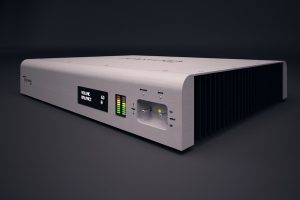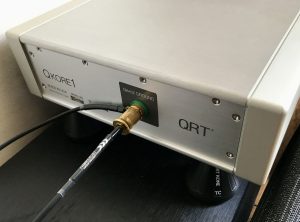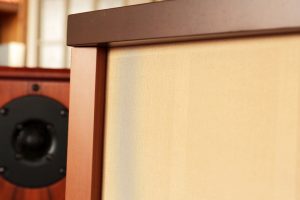Yayuma Audio, a company whose sound processor we wrote about in the February issue of High Fidelity (No. 154), was created out of passion and on the basis of knowledge. These two elements are something normal in the audio industry, but not necessarily in a combination. There are a lot of enthusiasts, indeed—what would a hobby without passion be? Here, in Poland, we have just as many specialists who have knowledge and skills thanks to which we can manage at any institute or universities all over the world. However, passion supported by knowledge and realized thanks to skills is a really special combination.
I have no doubt it was a coincidence, but a few days after the Yayuma ASP 01 processor was removed from my system, two strong men from a nearby construction site put a medium-sized wooden case at my door. They were being supervised by Mr. Bogdan Stasiak who thanked them politely, paid for assistance and looked at me with some doubt in his eyes—we were supposed to carry the platform home on our own.
His doubts were not connected with me in general, I assume, but with my physical abilities, as the Stacore Advanced platform weighs 94kg. This pneumatic anti-vibration platform that measures 580 x 480 x 140 mm and is made of damped slate, is the most advanced passive anti-vibration element I have ever used. Additionally, it has the best documented measurements I have ever seen for any product of this type. The measurements were conducted by Marcin Chodźko, Ph.D., D.Sc., Eng., at the Laboratory for Testing Machines and Mechanical Devices of the West Pomeranian University of Technology in Szczecin.
Types of Platforms
Anti-vibration platforms produced by different companies differ with regards to their design and solutions applied. Their classification is based on methodology developed for turntables. The basic division is related to their weight—there are light and heavy platforms. The former include, e.g. Acoustic Revive and Finite Elemente platforms, while the latter are, e.g. Harmonic Resolution Systems platforms. Some companies, such as Pro Audio Bono or Franc Audio Accessories, offer two types of platforms.
We can also classify platforms as non-decoupled (rigid) or decoupled (movable). The latter have two planes (a plinth or base and a sub-base), separated by a spring element or a rolling-element bearing. Non-decoupled platforms are manufactured by, e.g. Symposium, Franc Audio Accesories, Divine Acoustics, the above mentioned HRS and Acoustic Revive. Decoupled platforms are offered by, e.g. Pro Audio Bono, Acoustic Revive (RAF-48H), CEC/Well Float and also Monolith Audio. In one type of decoupled platforms magnets are used that pull two elements apart, produced by, e.g. the Italian SAP (Relaxa) company.
One can also classify some platforms as lightweight, with elements of a decoupled platform, but having a different look—e.g. Rogoz Audio platforms. These platforms make use of a spike placed in a bearing, with an intermediary element (the Balancing Board System).
Stacore Advanced
As we can read in company materials, Stacore is a combination of two words: stabilization and core. It is also possible to read the name in a different way: Stacore includes the first syllables of the surnames of two people behind the project: Bogdan STAsiak and Jarek KORbicz.
The company offers two platforms—the Basic and the Advanced model (tested by us). The difference is that the Advanced model includes a two-stage vibration control mechanism, thanks to which "full six-axis decoupling is achieved—the Holy Grail of vibration control" (source: company website).
Stacore platforms are pneumatic platforms. The idea has been known for years and used in, e.g. the Acoustic Revive RAF-48H and the G-CLEF Acoustic Wellfloat Board—we tested its version made for the CEC company. Both Japanese platforms originated in the laboratories of the University of Tokyo, where electron microscopes are decoupled in this way. It sounds proud, but in both cases we actually deal with something like a bike inner tube placed between two planes. The tube is inflated just like in a bike and the platforms themselves are quite lightweight (made of wood).
To cut a long story short: compared to the Stacore Advanced, these platforms look like the "creations" of preschoolers from an "arts kindergarten" versus a diploma work of a student from a good technical university. Stacore was created on the basis of intuition, experience in the field of top-class audio products and knowledge. Just like Acoustic Research and CEC platforms, the Advanced model is a pneumatic platform. However, it is made of slate and the top shelves are damped. On the side there is a classic car tire valve, three valves that make leveling possible and a manometer. To maintain the set pressure, it is only necessary to pump in some air every two months.
The structure stands on four pneumatic actuators. The two rear ones virtually function as one, as they are pneumatically connected. Each of the actuators ma has its own pneumatic damping system (expansion/compensation tanks) and each is separately pumped. The manometer makes it possible to adjust inner pressure to our preferences—by changing it, we change the resonance frequency of the platform itself.
The Advanced version (literally and metaphorically) ads one more "layer" to it. It is a damped slate stage, decoupled from the Basic platform using ball bearings. Such solutions are known and quite often used in the audio industry, e.g. in the CD Libretto HD CD player of the Hungarian Human Audio company the American Symposium Tungsten Superballs Double Stack Kit anti-vibration feet, or the Polish Avatar Audio (Polish) speaker feet and Monolith Audio platforms. They differ with regards to the manufacturing precision and selected materials. In Stacore platforms, ball bearings are made of hardened polished stainless steel, while the balls are made of tungsten carbide. The upper plane is flat, not convex, thanks to which very high sensitivity is achieved.
A few simple words with…
JAREK KORBICZ
Constructor
Apart from pure power supply, the elimination of vibrations is one of the most important factors that make it possible o maximize the capabilities of any audio system.
Since the beginning, Stacore anti-vibration platforms have been designed and constructed for audio applications. Our designs include our own broadband vibration damping solutions and can be used under any component of an audio system (e.g. a CD player, a DAC, an amplifier—especially with large tubes—and speakers), effectively isolating it from vibrations. The heart of Stacore platforms is a unique combination of pneumatic suspension and highly damped casing made of amorphous slate. The suspension is based on industrial/laboratory elements, has excellent damping characteristics and offers high reliability.
The appropriately selected casing material, directly imported from mines in northern Italy and additionally damped, ensures excellent broadband vibration damping, most importantly where pneumatic suspension stops working. The stone has been really carefully machined and impregnated using suitable substances, not only in order to give it appropriate noble look but also resistance to light scratches and aging. The whole casing is made by hand. The sublime elegant look definitely adds value. The impact the platform has on an audio system can be compared to the state of our senses right after we take earplugs out or clean a dirty window. The first impression of relief and satisfaction gives us the possibility to fully hear both the recorded material and the whole system.
We offer two versions of the platform: Stacore Basic and Stacore Advanced. The Advanced platform is a unique solution on the market as, apart from pneumatic damping, it includes a second damping stage based on roller bearings. This significantly improves vibration decoupling on the horizontal plane. In this way, the Stacore Advanced platform achieves the so-called full six-axis decoupling—the Holy Grail of vibration control systems. The ball bearings (our own in-house design) are made of hardened stainless steel and contain tungsten carbide balls, thanks to which even the smallest vibrations can be controlled during a long product usage period, even under heavy devices.
It all makes the "sound window" more open to the audio system, reveals its true potential and ensures closer contact with music, often combined with rediscovering the "flavors" of our recordings.
Mr Bogdan Stasiak standing next to a platform that is being prepared for a test
Test Methodology
The maximum load of the Advanced platform is 65 kg, which means that the platform combined with a single device can weigh up to 160kg. If we want to decouple two elements, the platforms themselves will weigh 184kg. Mr Jarek Korbicz, who is expanding his system in this way, now has reached 650 kg in platforms themselves. This is what I call "going all out".
In my system, the basic rack is the Finite Elemente Pagode Edition with a classic top shelf (a "heavy duty" version is also available). It means that I can put up to 60kg on it, which excluded the Stacore platform from the equation. So, together with Mr Bogdan Stasiak, who delivered the platform to me, we had to compile a special "rack" just to place the platform on. We made it using two Sonus Faber speaker stands on which we put a slate panel. Then, we placed the platform on the top of that structure.
The comparison consisted in listening to the Ancient Audio lektor AIR V-edition player. It was an A/B/A comparison (A and B known). The listening session was divided into two stages. During the first one, the player was placed on the top shelf of the Finite Elemente rack first and then on the platform. During the second stage, the Acoustic Revive RAF-48H pneumatic platform was placed on the rack. In both cases, the Franc Audio Accessories Ceramic Disc Classic feet were put under the player.
Mr Bogdan gave them a critical look, but not because he did not trust them. As we can read on the manufacturer’s website, they advise not to double decoupling on the same plane, as, in extreme cases, rumbling may occur. I did not notice anything of that sort in our system, so the feet remained where they were placed.
SOUND
- Andrzej Kurylewicz Quintet, Go Right, Polskie Nagrania "Muza"/Warner Music Poland 4648809, "Polish Jazz | vol. 0", Master CD-R (1963/2016); review HERE
- Ariel Ramirez, Misa Criolla, José Carreras, Philips/Lasting Impression Music LIM K2HD 040, K2HD Mastering, "24 Gold Direct-from-Master Edition UDM", CD-R (1964/2009)
- Artur Lesicki Acoustic Harmony, Stone & Ashes, Fonografika, 559040, Master CD-R (2010); review HERE
- Bogdan Hołownia, Chwile, Sony Music Polska 5052882, Master CD-R (2001)
- Dżem, Zemsta nietoperzy, Pronit/remaster Damian Lipiński (unpublished material), Master CD-R (1987/2015)
- Kankawa, Organist, T-TOC Records, UMVD-0001-0004, "Ultimate Master Vinyl", 4 x 45 rpm 180 g LP + CD-RIIα + 24/192 WAV; review HERE.
- Perfect, Unu, Tonpress/remaster Damian Lipiński (unpublished material), Master CD-R (1982/2015)
- Polish Jazz Quartet, Polish Jazz Quartet, Polskie Nagrania "Muza"/Warner Music Poland, "Polish Jazz vol. 3", Master CD-R (1965/2016); review HERE
- Stan Getz/Joao Gilberto, Getz/Gilberto, Verve/Lasting Impression Music LIM K2HD 036, K2HD Mastering, "24 Gold Direct-from-Master Edition UDM", CD-R (1964/2009)
- The Oscar Peterson Trio, We Get Request, Verve/Lasting Impression Music LIM K2HD 032, K2HD Mastering, "24 Gold Direct-from-Master Edition UDM", CD-R (1964/2009)
Listening to the Stacore platform confirmed my observations related to sound changes introduced by so-called heavy platforms, but also changed some of my views on them that I was sure were "correct". As always, dealing with something new (and good) teaches us humility. I think that we still understand very little about vibration damping in audio systems (specifically in this field, not in general). However, thanks to having an opportunity to use the platform from Miszew, I now know a little more.
Comparing the platform to the Pagode Edition rack revealed the shortages of the German device. I had been aware of some of them, but other ones surprised me, especially when it came to the depth of changes that took place after placing the player on the Stacore platform. The thing that is, in my opinion, most important in this sound and that we fight for in every high-end product, is resolution. When the Stacore platform was used, sound immediately became open and clean. It resulted in differentiation that I had probably not had in my system before—well, perhaps I had, but with the best players and turntables.
This makes an incredible impression wherever we thought we had pleasant but a bit rounded sound, like, for example, in the case of Polish Jazz remasters that I have on Master CD-Rs. They are the closest to what the mastering specialist heard in the studio and I must say that only the Polish platform showed this so well. The number of sounds, harmonics and the kind of a "halo" around the instruments—it all became richer, more mature and stronger.
Perhaps because of so much new information, it seemed that the player played music louder when it was placed on slate. It was not so, but the impression was strong. In fact, the difference consisted in much clearer sound; there was "more" of everything and the sound was more intensive. The platform releases unique energy. It is something I had not anticipated at all, since all my previous experience told me that heavy platforms and turntables usually put out some energy—by ordering sound, they damp it a little. This is perhaps the reason why wood is still most often used in Japan.
So, we have resolution and the resulting differentiation that is not limited to dynamics and tone but also refers to sound planes. After we took the Ancient Audio player of the German rack and placed it on the Stacore platform, the sound stage became very deep. The differentiation on the front-back axis was much better and unequivocal now. I constantly read descriptions that positively emphasize or are often ecstatic about "cutting out" instruments from the background. In my opinion, this is nonsense—it is actually an error—either made by the sound engineer, if it is really present in a recording, or typical for the system that highlights this phenomenon. The real world and good recordings are connected, and everything interacts together to create a musical event. Stacore does not cut anything out but "only" differentiates. Thanks to that, recordings are closer to live music.
Together with all of this, we also get a wider bandwidth. I had no doubt that sound was "broader" with the Polish platform—also the bass and the high treble were better characterized. Perhaps this is why I obtained an incredibly rich sound of the percussion cymbals. When it comes to bass, the sound was not lowered but more focused. It was as if the sound attack was changed. It could be clearly heard that the Finite Elemente rack, even with the Acoustic Revive RAF-48H platform, warms sound up and blurs part of the attack, especially at lower frequencies. Together, they give us bigger and more "physiological" sound, which is incredibly pleasant. However, I can hear it now, it is a kind of an "enhancer" that has the same impact on all recordings.
As I say, I know how heavy platforms work and, except for a few, they put out energy. It is often desired, especially if something in the system is not balanced too well, but in the end it is a step into a wrong direction—hence my choices regarding the rack and the platforms. The Stacore platform calms down the modern midrange and makes it a bit leaner. The Stacore company states that this can be corrected by changing the pressure, but my experience shows that it is a permanent feature of all heavy platforms (and turntables). It is all accordant with my previous experience, but for the first time it was connected with what I wrote about earlier, i.e. better resolution. Resolution most often means more "warmth" in sound. The inverted commas are used for a purpose here, as I do not mean "warming up". Simply, more information means more natural sound and natural sound has no trace of brightening up or sharpening. Everything that aims to improve this state of things is a return to normality.
So, even though the Stacore platform lifts the center of gravity, it shows a more natural sound of recordings. If it appears that the source produces too bright sound with it, it means the source has a problem with tone or that the modification occurs in another element of the system. That is why wooden and lightweight anti-vibration elements are so universal—even if they are not too well thought-out, they do not "harm" anything. However, they neither move the system towards what we desire most—i.e. better reliability. In the end, reliability is what the audio domain is about. This is supposed to be "real" sound, i.e. sound that leads us faster to the so-called "suspension of disbelief"—convinces us and makes us want to live with it. The Pomeranian platform enchanted me in exactly this way—one wants to listen to recordings with it, even those that have been kept on a shelf for a long time.
Summary
I assure you that the Stacore platform is one of the best anti-vibration products now available on the audio market. In the case of some elements, things can only get better with active platforms. These, in turn, have their drawbacks—after all, these are elements that react to vibration after it occurs. What is more, their operating bandwidth is maximum 1kHz. Anything above that is pure lottery, as these platforms are not designed for audio systems but for microscopes. A broadband damped active platform dedicated for audio devices has not been created yet.
So, if you have a suitable rack and matching high-quality equipment, go for it and you won’t regret it. Only the people who value dense lower midrange above anything else, even at the cost of lower readability, should take a different path. I address the following Morpheus’s words from the Matrix movie to all the rest: "Welcome to the real world…" (The Matrix, directed by Laurence Wachowski and Andrew Wachowski, 1999).
Advanced Platform
Retail: 5900 Euro (VAT included)
Stacore
Miszewo, ul. Kartuska 4
80-297 Banino | Poland
MADE IN POLAND
The tested product was supplied by: STACORE
Text: Wojciech Pacuła
Photos: Stacore | Wojciech Pacuła
Translation: Ewa Muszczynko













































